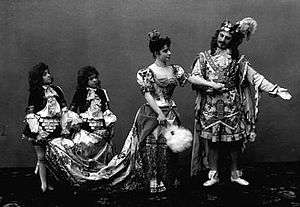Mariinsky Ballet
| Mariinsky Ballet | |
|---|---|
 | |
| General information | |
| Name | Mariinsky Ballet |
| Previous names |
|
| Year founded | Approx. 1740 |
| Principal venue |
Mariinsky Theatre 1 Theatre Square St Petersburg |
| Website | www.mariinsky.ru/en |
| Artistic staff | |
| Artistic Director |
Valery Gergiev (Mariinsky Theatre) |
| Deputy Director |
|
| Reserve Troupe Director | Andrei Bugaev |
| Other | |
| Parent company | Mariinsky Theatre |
| Associated schools | Vaganova Ballet Academy |
| Formation |
|
The Mariinsky Ballet is the resident classical ballet company of the Mariinsky Theatre in Saint Petersburg, Russia. Founded in the 18th century and originally known as the Imperial Russian Ballet, the Mariinsky Ballet is one of the world's leading ballet companies. Internationally, the Mariinsky Ballet continues to be known by its former Soviet name the Kirov Ballet. The Mariinsky Ballet is the parent company of the Vaganova Ballet Academy, a leading international ballet school.
History

The Mariinsky Ballet was founded in the 1740s, following the formation of the first Russian dance school in 1738.
The Imperial Theatre School as it was originally known, was established on 4 May 1738, at the Winter Palace in Saint Petersburg. It would become the predecessor of today's Vaganova Ballet Academy. The school's founder director was the French ballet master and teacher Jean-Baptiste Landé and the purpose of creating the school was to train young dancers to form the first Russian ballet company. The first group of students included twelve boys and twelve girls, who later went on to form what would become the predecessor of today's Mariinsky Ballet.
Very little information exists from the formative years of the ballet company, however it is known that both the school and the ballet company were linked by name, becoming the Imperial Ballet School and Imperial Russian Ballet, names that continued to be used until the abolition of Imperial rule. In the late 18th and early 19th centuries, the Imperial Russian Ballet soon rose to prominence and would employ some of the most influential and famous names in ballet history including Charles Didelot, Marie Taglioni, Christian Johansson, Enrico Cecchetti, Jules Perrot, Fanny Cerrito and Carlotta Grisi.
Following the Russian Revolution, the Soviet government decided that the ballet school and company were unwanted symbols of the tsarist regime and went on to close them both. The ballet company was the first to be re-established, becoming known as the Soviet Ballet, with the school re-opening later as the Leningrad State Choreographic School, both remaining in their previous locations.
Following the assassination of the Bolshevik revolutionary Sergey Kirov in 1934, the then Soviet Ballet was renamed the Kirov Ballet, a name which is still sometimes incorrectly used. After the end of communist rule, both the ballet company and opera company at the Mariinsky Theatre were linked to the theatre by name, becoming the Mariinsky Ballet and Mariinsky Opera and both companies are run by the theatre itself.
Despite later name changes and pressures of the Russian revolution, the present day Mariinsky Ballet is still linked to the school, which is now known as the Vaganova Ballet Academy.
Today

The Mariinsky Ballet is today recognised as one of the world's greatest ballet companies, employing over 200 dancers, including a reserve troupe and character artists. The Director of the Mariinsky Ballet is Yuri Fateyev.
Being modelled on other leading opera/ballet theatres such as the Royal Opera House, London and La Scala, Milan, the Mariinsky Ballet and Mariinsky Opera both come under the management of the Mariinsky Theatre, with Valery Gergiev as Artistic Director. He is also the Director of the opera company. The two companies operate as separate units.
Repertoire
 |
|
|
|
Dancers
The basis of the Mariinsky Ballet consists of the following artists:[1]
Principals
- Ekaterina Kondaurova
- Ulyana Lopatkina
- Yulia Makhalina
- Daria Pavlenko
- Oksana Skorik
- Alina Somova
- Viktoria Tereshkina
- Diana Vishneva
- Timur Askerov
- Yevgeny Ivanchenko
- Kimin Kim
- Igor Kolb
- Vladimir Shklyarov
- Danila Korsuntsev
- Denis Matvienko (guest soloist)
First Soloists
|
|
|
|
Second Soloists
|
|
|
|
Principal Character Artists
|
|
Coryphees
|
|
|
|
Marius Petipa
For a number of years, Marius Petipa was the ballet master of the Imperial Russian Ballet. One of the most famous names in ballet history, Petipa was the choreographer of some of the best known classical ballets including:
Notable dancers
References
- ↑ "Soloists of the ballet company". Mariinsky Theatre. Retrieved 2016-08-17.
External links
- Official website (English)
- Official website (Russian)
- Mariinsky Ballet International Tour Schedule - Mariinsky Foundation Website
- Additional Information/Pictures about the Mariinsky-Kirov Ballet
- More information and interviews from the Kirov Ballet
- Winston, Rory (2008-04-15). "Dance Review: The Kirov Ballet". New York Resident. Retrieved 2008-10-04.
- NY Times article by Lawrence van Gelder, March 25, 2008
- Kennedy Center: Information about Mariinsky Ballet accessed 4 October 2008